

Statistiquement, il n'y a que six façons de raconter une histoire. En passant 1 700 romans au crible de l’analyse statistique, une équipe de chercheurs a démontré qu’il n’existait que six grands types d’arcs narratifs. © Bleecker Street La littérature de fiction est une chose sublime et merveilleuse, un univers d’émotions verbalisées dont la richesse, la complexité et l’originalité s’étoffent à chaque seconde de nos vies : c’est ce que vous dira, en substance, n’importe quel fan de lecture.

Pour une approche plus cartésienne, en revanche, dirigeons-nous vers l’analyste statistique Andrew Reagan et ses collègues de l’Université du Vermont à Burlington, qui viennent de publier une étude passionnante qui brise le mythe de la créativité littéraire. En bon statisticien, Reagan a compilé 1 700 textes de fiction téléchargés au moins 150 fois sur le site du Projet Gutenberg (qui propose en téléchargement gratuit plus de 36 000 livres numériques) et leur a appliqué une méthode d’analyse, plutôt directe, pour en faire ressortir les arcs narratifs. Karpman drama triangle. Classic drama triangle[1] The drama triangle is a psychological and social model of human interaction in transactional analysis (TA) first described by Stephen Karpman, M.D., in his 1968 article "Fairy Tales and Script Drama Analysis".[3] The drama triangle model is used in psychology and psychotherapy.[4][5] The three roles[edit] The model posits three habitual psychological roles (or roleplays) which people often take in a situation: Of these, the rescuer is the least obvious role.
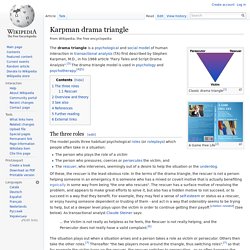
The Dramatic Arc.pdf. Kurt Vonnegut on the shapes of stories. Schéma narratif. Periodic Table of Storytelling. The Story Spine.pdf. Monomyth. Joseph Campbell's monomyth, or the hero's journey, is a basic pattern that its proponents argue is found in many narratives from around the world.

This widely distributed pattern was described by Campbell in The Hero with a Thousand Faces (1949).[1] Campbell, an enthusiast of novelist James Joyce, borrowed the term monomyth from Joyce's Finnegans Wake.[2] Campbell held that numerous myths from disparate times and regions share fundamental structures and stages, which he summarized in The Hero with a Thousand Faces: A hero ventures forth from the world of common day into a region of supernatural wonder: fabulous forces are there encountered and a decisive victory is won: the hero comes back from this mysterious adventure with the power to bestow boons on his fellow man.[3] Hero's journey. "A Practical Guide to Joseph Cambell’s The Hero with a Thousand Faces" by Christopher Vogler © 1985 “There are only two or three human stories, and they go on repeating themselves as fiercely as if they had never happened before.”
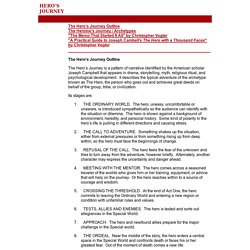
In the long run, one of the most influential books of the 20th century may turn out to be Joseph Campbell’s THE HERO WITH A THOUSAND FACES. The book and the ideas in it are having a major impact on writing and story-telling, but above all on movie-making. Freytag's Pyrmaid. The Golden Circle. Three-act structure. Three- act structure Plot Line Graph by Wendell Wellman The three-act structure is a model used in writing, including screenwriting, and in evaluating modern storytelling that divides a fictional narrative into three parts, often called the Setup, the Confrontation and the Resolution.
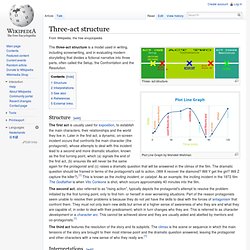
Structure[edit] The second act, also referred to as "rising action", typically depicts the protagonist's attempt to resolve the problem initiated by the first turning point, only to find him- or herself in ever worsening situations. Part of the reason protagonists seem unable to resolve their problems is because they do not yet have the skills to deal with the forces of antagonism that confront them. The tone of voice triangle. Is humor part of your brand’s personality?

Do you wonder if it should be? Principe KISS. Un article de Wikipédia, l'encyclopédie libre.
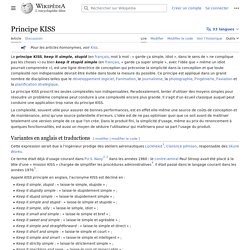
Il est important de noter que le principe KISS proscrit les seules complexités non indispensables. Paradoxalement, tenter d'utiliser des moyens simples pour résoudre un problème complexe peut conduire à une complexité encore plus grande. Il s'agit d'un écueil classique auquel peut conduire une application trop naïve du principe KISS.
Kishōtenketsu. Kishōtenketsu (起承転結?)
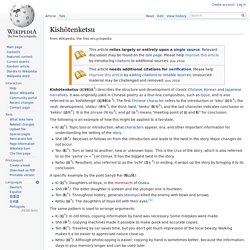
Describes the structure and development of classic Chinese, Korean and Japanese narratives. It was originally used in Chinese poetry as a four-line composition, such as Qijue, and is also referred to as 'kishōtengō' (起承転合?). The first Chinese character refers to the introduction or 'kiku' (起句?) Jo-ha-kyū. Jo-ha-kyū (序破急?)
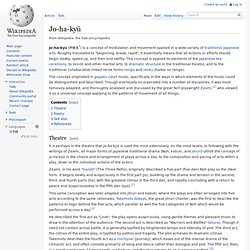
Is a concept of modulation and movement applied in a wide variety of traditional Japanese arts. Roughly translated to "beginning, break, rapid", it essentially means that all actions or efforts should begin slowly, speed up, and then end swiftly. This concept is applied to elements of the Japanese tea ceremony, to kendō and other martial arts, to dramatic structure in the traditional theatre, and to the traditional collaborative linked verse forms renga and renku (haikai no renga). The concept originated in gagaku court music, specifically in the ways in which elements of the music could be distinguished and described. Though eventually incorporated into a number of disciplines, it was most famously adapted, and thoroughly analysed and discussed by the great Noh playwright Zeami,[1] who viewed it as a universal concept applying to the patterns of movement of all things.
Theatre[edit] Storyboard template (.pdf)
Michel chion, écrire un scénario, - PDFQueen - PDF Search engine. Anatomie du film de genre.